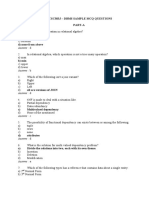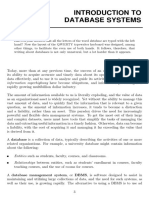Ch20 Updated 2023
Ch20 Updated 2023
Uploaded by
maya khanCopyright:
Available Formats
Ch20 Updated 2023
Ch20 Updated 2023
Uploaded by
maya khanCopyright
Available Formats
Share this document
Did you find this document useful?
Is this content inappropriate?
Copyright:
Available Formats
Ch20 Updated 2023
Ch20 Updated 2023
Uploaded by
maya khanCopyright:
Available Formats
1
Chapter 20
Transaction Management
Transparencies
© Pearson Education Limited 1995, 2005
2 Chapter 20 - Objectives
Function and importance of transactions.
Properties of transactions.
Concurrency Control
Meaning of serializability.
How locking can ensure serializability.
Deadlock and how it can be resolved.
How timestamping can ensure serializability.
Optimistic concurrency control.
Granularity of locking.
© Pearson Education Limited 1995, 2005
3 Chapter 20 - Objectives
Recovery Control
Some causes of database failure.
Purpose of transaction log file.
Purpose of checkpointing.
How to recover following database failure.
Alternative models for long duration transactions.
© Pearson Education Limited 1995, 2005
4 Transaction Support
Transaction
Action, or series of actions, carried out by user or
application, which reads or updates contents of
database.
Logical unit of work on the database.
Application program is series of transactions with non-
database processing in between.
Transforms database from one consistent state to
another, although consistency may be violated during
transaction.
© Pearson Education Limited 1995, 2005
5 Example Transaction
© Pearson Education Limited 1995, 2005
6 Transaction Support
Can have one of two outcomes:
Success - transaction commits and database reaches a
new consistent state.
Failure - transaction aborts, and database must be
restored to consistent state before it started.
Such a transaction is rolled back or undone.
Committed transaction cannot be aborted.
Aborted transaction that is rolled back can be restarted later.
© Pearson Education Limited 1995, 2005
7 State Transition Diagram for
Transaction
© Pearson Education Limited 1995, 2005
8 Properties of Transactions
Four basic (ACID) properties of a transaction are:
Atomicity ‘All or nothing’ property.
Consistency Must transform database from one consistent
state to another.
Isolation Partial effects of incomplete transactions
should not be visible to other transactions.
Durability Effects of a committed transaction are
permanent and must not be lost because of later failure.
© Pearson Education Limited 1995, 2005
9 Concurrency Control
Process of managing simultaneous operations on the database without
having them interfere with one another.
Prevents interference when two or more users are accessing database
simultaneously and at least one is updating data.
Although two transactions may be correct in themselves, interleaving of
operations may produce an incorrect result.
© Pearson Education Limited 1995, 2005
10 Need for Concurrency Control
Three examples of potential problems caused by concurrency:
Lost update problem.
Uncommitted dependency problem.
Inconsistent analysis problem.
© Pearson Education Limited 1995, 2005
11 Lost Update Problem
Successfully completed update is overridden by another user.
T1 withdrawing £10 from an account with balx, initially £100.
T2 depositing £100 into same account.
Serially, final balance would be £190.
© Pearson Education Limited 1995, 2005
12 Lost Update Problem
Loss of T2’s update avoided by preventing T1 from reading balx until after
update.
© Pearson Education Limited 1995, 2005
13 Uncommitted Dependency Problem
Occurs when one transaction can see intermediate results of another
transaction before it has committed.
T4 updates balx to £200 but it aborts, so balx should be back at original
value of £100.
T3 has read new value of balx (£200) and uses value as basis of £10
reduction, giving a new balance of £190, instead of £90.
© Pearson Education Limited 1995, 2005
14 Uncommitted Dependency Problem
Problem avoided by preventing T3 from reading balx until after T4
commits or aborts.
© Pearson Education Limited 1995, 2005
15 Inconsistent Analysis Problem
Occurs when transaction reads several values but second transaction
updates some of them during execution of first.
Sometimes referred to as dirty read or unrepeatable read.
T6 is totaling balances of account x (£100), account y (£50), and account z
(£25).
Meantime, T5 has transferred £10 from balx to balz, so T6 now has wrong
result (£10 too high).
© Pearson Education Limited 1995, 2005
16 Inconsistent Analysis Problem
Problem avoided by preventing T6 from reading balx and balz until after T5
completed updates.
© Pearson Education Limited 1995, 2005
17 Concurrency Control Techniques
Two basic concurrency control techniques:
Locking,
Timestamping.
Both are conservative approaches: delay transactions in case they conflict
with other transactions.
Optimistic methods assume conflict is rare and only check for conflicts at
commit.
© Pearson Education Limited 1995, 2005
18 Locking
Transaction uses locks to deny access to other transactions and so prevent
incorrect updates.
Most widely used approach to ensure serializability.
Generally, a transaction must claim a shared (read) or exclusive (write) lock on
a data item before read or write.
Lock prevents another transaction from modifying item or even reading it, in
the case of a write lock.
© Pearson Education Limited 1995, 2005
19 Locking - Basic Rules
If transaction has shared lock on item, can read but not update item.
If transaction has exclusive lock on item, can both read and update item.
Reads cannot conflict, so more than one transaction can hold shared locks
simultaneously on same item.
Exclusive lock gives transaction exclusive access to that item.
A transaction continues to hold a lock until it explicitly releases it either
during execution or when it terminates (aborts or commits). It is only when
the exclusive lock has been released that the effects of the write operation will
be made visible to other transactions.
Some systems allow transaction to upgrade read lock to an exclusive lock, or
downgrade exclusive lock to a shared lock.
© Pearson Education Limited 1995, 2005
20 Two-Phase Locking (2PL)
Transaction follows 2PL protocol if all locking operations precede first
unlock operation in the transaction.
Two phases for transaction:
Growing phase - acquires all locks but cannot release any locks.
Shrinking phase - releases locks but cannot acquire any new locks.
© Pearson Education Limited 1995, 2005
21 Preventing Lost Update Problem using
2PL
© Pearson Education Limited 1995, 2005
22 Preventing Uncommitted Dependency
Problem using 2PL
© Pearson Education Limited 1995, 2005
23 Preventing Inconsistent Analysis
Problem using 2PL
© Pearson Education Limited 1995, 2005
You might also like
- Adbms-Practice Questions: (7 Marks)Document9 pagesAdbms-Practice Questions: (7 Marks)Hyder LapnupiNo ratings yet
- Lecture 10 - Transaction MGMT New 2Document28 pagesLecture 10 - Transaction MGMT New 2FRankNo ratings yet
- DBS Connolly 2004 Slides20 Transaction ManagementDocument117 pagesDBS Connolly 2004 Slides20 Transaction Managementapi-3754419No ratings yet
- ch08 - Transactions Management - 2Document43 pagesch08 - Transactions Management - 2beshahashenafe20No ratings yet
- Transcations KannapiDocument26 pagesTranscations KannapiSandesh DmelloNo ratings yet
- Ch#22 TRANSACTION - MANAGEMENTDocument80 pagesCh#22 TRANSACTION - MANAGEMENTBSE- 4BNo ratings yet
- MIS403 Lec15 Nov14Document24 pagesMIS403 Lec15 Nov14mmpdh227dfNo ratings yet
- Tutorial 10 DDDDocument3 pagesTutorial 10 DDDAmir 'daboss' Bukan100% (2)
- Lab 14Document23 pagesLab 14Nasir AliNo ratings yet
- Unit V TC PDFDocument52 pagesUnit V TC PDFAryanNo ratings yet
- TransactionsDocument81 pagesTransactionsANDFAN DAKANo ratings yet
- Chapter 1 Transaction Management & Concurrency ControlDocument89 pagesChapter 1 Transaction Management & Concurrency ControlEsubalew ChekolNo ratings yet
- Abido Adanced Database SystemsDocument44 pagesAbido Adanced Database SystemsAyele MitkuNo ratings yet
- Adanced Database Systems (Modified)Document48 pagesAdanced Database Systems (Modified)tizitatesfaye073No ratings yet
- Transaction ManagementDocument30 pagesTransaction ManagementXenos Playground aka Boxman StudiosNo ratings yet
- Transactions and Concurrency Management: Unit-IvDocument21 pagesTransactions and Concurrency Management: Unit-IvlalithaNo ratings yet
- DBMS Classtest2Document10 pagesDBMS Classtest2Mr. Skull EditorNo ratings yet
- HpdsDocument12 pagesHpdsCandi MiddletonNo ratings yet
- Lock-Based Concurrency ControlDocument24 pagesLock-Based Concurrency ControlSaurya MishraNo ratings yet
- TransactionsDocument33 pagesTransactionsAhmad MujtabaNo ratings yet
- DatabasDocument11 pagesDatabashani khanNo ratings yet
- 8 Transaction-ProcessingDocument55 pages8 Transaction-ProcessingSurendraNo ratings yet
- Module 05Document9 pagesModule 05Shreyas B RNo ratings yet
- Lecture05 UCCD2303 Transaction Management Part 1Document56 pagesLecture05 UCCD2303 Transaction Management Part 1Teh Kai ZeNo ratings yet
- QAch 15Document33 pagesQAch 15El Basmala100% (1)
- ACIDDocument17 pagesACIDJohn Ivan MauratNo ratings yet
- IT3306 - 05 - Consistency and Transaction Processing ConceptsDocument178 pagesIT3306 - 05 - Consistency and Transaction Processing ConceptskkNo ratings yet
- Concurrency Control DBMSDocument12 pagesConcurrency Control DBMSpthepronabNo ratings yet
- Unit 4Document13 pagesUnit 4Bhanu Prakash ReddyNo ratings yet
- Unit 5Document7 pagesUnit 5rohitkhushalani77No ratings yet
- Database Questions AnswerDocument7 pagesDatabase Questions AnswerNabina LimbuNo ratings yet
- Transaction Management and ARIESDocument35 pagesTransaction Management and ARIESsaloya1764No ratings yet
- Module 5 - NOTESDocument32 pagesModule 5 - NOTESujr.umrNo ratings yet
- Transaction 2Document31 pagesTransaction 2pradeep_gupta43No ratings yet
- Computer SecurityDocument17 pagesComputer Securitymohammadaglodiya2004No ratings yet
- 5th Unit NotesDocument14 pages5th Unit NotesHariniNo ratings yet
- 5 Concurrency ControlDocument4 pages5 Concurrency Controlpeter njugunaNo ratings yet
- Lect 15 - Transaction and Concurrency ControlDocument53 pagesLect 15 - Transaction and Concurrency ControlzanchoozanchooNo ratings yet
- Database Transaction, Concurrentcy Control and LockingDocument12 pagesDatabase Transaction, Concurrentcy Control and LockingKimberly Mae HernandezNo ratings yet
- Database ConcurrencyDocument39 pagesDatabase ConcurrencySushantNo ratings yet
- Week 12 Database ConcurrencyDocument37 pagesWeek 12 Database ConcurrencyWhat the bugNo ratings yet
- Advanced Transaction Processing: Solutions To Practice ExercisesDocument4 pagesAdvanced Transaction Processing: Solutions To Practice ExercisesIhsan UllahNo ratings yet
- Lecture 3.6 - Introduction To Transaction Processing and Lecture 3.7 - Transaction Properties and StatesDocument43 pagesLecture 3.6 - Introduction To Transaction Processing and Lecture 3.7 - Transaction Properties and Statesbobbinpreet kaurNo ratings yet
- Transaction ManagementDocument26 pagesTransaction ManagementZarnab sarfrazNo ratings yet
- Concurrency Control Techniques Unit IIIDocument32 pagesConcurrency Control Techniques Unit IIIKIRUTHIKANo ratings yet
- Module 5Document74 pagesModule 5Davu LikithaNo ratings yet
- Transaction ProcessingDocument22 pagesTransaction Processinganon_600750922No ratings yet
- DC Unit-IVDocument18 pagesDC Unit-IVWISY JESINTHA S SNSRCASNo ratings yet
- Concurrency ExercisesDocument4 pagesConcurrency ExercisesOviya MeenhaaNo ratings yet
- Concurrency Control DbmsDocument49 pagesConcurrency Control DbmsChinmay KunkikarNo ratings yet
- Adbms Unit 3 NotesDocument28 pagesAdbms Unit 3 Notessurendrareddy mandatiNo ratings yet
- Unit 4Document55 pagesUnit 4atharvnawale05No ratings yet
- DDS Unit - 3Document15 pagesDDS Unit - 3pratapshivamsidNo ratings yet
- Database Fundamental (TIS 1101 Tutorial 10Document3 pagesDatabase Fundamental (TIS 1101 Tutorial 10Blackk WorldzNo ratings yet
- Chapter 3 Transaction ProcessingDocument29 pagesChapter 3 Transaction ProcessingZedNo ratings yet
- Unit 5Document8 pagesUnit 5dipakdas84630No ratings yet
- DDB5Document5 pagesDDB5Ivan HfosNo ratings yet
- 10 Transactions 2Document36 pages10 Transactions 2fake accountNo ratings yet
- Elmasri 6e Ch21Document54 pagesElmasri 6e Ch21Marwan Aly MohamedNo ratings yet
- Lecturenotes Module-5 BCS403 DatabasemanagementsystemDocument20 pagesLecturenotes Module-5 BCS403 Databasemanagementsystemtharanir.aimlNo ratings yet
- Visual BasicDocument7 pagesVisual Basicmaya khanNo ratings yet
- VP AssignmentDocument1 pageVP Assignmentmaya khanNo ratings yet
- Data Structures and Algorithms Chapter 1Document29 pagesData Structures and Algorithms Chapter 1maya khanNo ratings yet
- Maths Remaining CourseDocument17 pagesMaths Remaining Coursemaya khanNo ratings yet
- E. Lab Task 12Document4 pagesE. Lab Task 12maya khanNo ratings yet
- Chapter 10Document9 pagesChapter 10maya khanNo ratings yet
- Structure of Mobile Computing ApplicationDocument2 pagesStructure of Mobile Computing ApplicationmasimevanistelrooyNo ratings yet
- Difference Between Dirty Read, Non Repeatable Read and Phantom Read in DatabaseDocument1 pageDifference Between Dirty Read, Non Repeatable Read and Phantom Read in Databasecompiler&automataNo ratings yet
- Unit-1 FinalDocument45 pagesUnit-1 FinalArunprasad JerusalemNo ratings yet
- Lecture 1.1 and 1.2 (Database Concepts and Database System Architecture)Document22 pagesLecture 1.1 and 1.2 (Database Concepts and Database System Architecture)ANAND kumarNo ratings yet
- JNTUH Syllabus 2013 M.Tech CSEDocument33 pagesJNTUH Syllabus 2013 M.Tech CSESRINIVASA RAO GANTANo ratings yet
- Assignment 8 NPTEL DBMS January 2024Document10 pagesAssignment 8 NPTEL DBMS January 2024no.reply15203No ratings yet
- Chapter 16Document73 pagesChapter 16Shivang TomarNo ratings yet
- DDBMS PracticalsDocument24 pagesDDBMS PracticalsDoon ValyNo ratings yet
- 18CSC303J DBMS Sample MCQDocument12 pages18CSC303J DBMS Sample MCQK MAHESHWARI (RA1811031010041)No ratings yet
- Chameli Devi Group of Institutions: Cs502 Dbms Unit-4 Concurrency ControlDocument33 pagesChameli Devi Group of Institutions: Cs502 Dbms Unit-4 Concurrency Controlsignup onsitesNo ratings yet
- Operating System Server: Dining Philosophers Problem Using SemaphoresDocument20 pagesOperating System Server: Dining Philosophers Problem Using SemaphoresJacek KlosNo ratings yet
- Chapter 16: Concurrency Control: Database System Concepts 5 EdDocument79 pagesChapter 16: Concurrency Control: Database System Concepts 5 Edankit boxerNo ratings yet
- DDB Final Note (Full)Document13 pagesDDB Final Note (Full)Sayem HasanNo ratings yet
- Narvacan - Week 5 - 6 Concurrecy - Processes Synchronization and DeadlocksDocument24 pagesNarvacan - Week 5 - 6 Concurrecy - Processes Synchronization and DeadlocksArnold NarvacanNo ratings yet
- Aditya Silver Oak Institute of Technology Department of Computer EngineeringDocument10 pagesAditya Silver Oak Institute of Technology Department of Computer EngineeringRajput RahateNo ratings yet
- Chapter 6Document28 pagesChapter 6sure516vNo ratings yet
- Chapter 7 - Part 1Document157 pagesChapter 7 - Part 1Madhu ShuklaNo ratings yet
- Transaction Management and Concurrency Control and Recovery in DBMSDocument68 pagesTransaction Management and Concurrency Control and Recovery in DBMSSarah MathibeNo ratings yet
- Unit 4Document104 pagesUnit 4deekshitha ReddyNo ratings yet
- Advantages and DisadvantagesDocument2 pagesAdvantages and Disadvantagessomu6402No ratings yet
- TC 1Document24 pagesTC 1Amjad LeghariNo ratings yet
- Unit-4: - Design Axiom - Designing Classes - Access Layer - Object Storage - Object InteroperabilityDocument84 pagesUnit-4: - Design Axiom - Designing Classes - Access Layer - Object Storage - Object Interoperabilityjayaprasanna123No ratings yet
- Introduction To Database Systems: Information Superhighway Have Become Ubiquitous, and Information Processing Is ADocument21 pagesIntroduction To Database Systems: Information Superhighway Have Become Ubiquitous, and Information Processing Is AJan Christopher Dumale DecoroNo ratings yet
- Dbms Gate NotesDocument574 pagesDbms Gate Notesshubhraj3263No ratings yet
- Corfu DBDocument5 pagesCorfu DBKeshav RathiNo ratings yet
- 5 A) SemaphoresDocument2 pages5 A) Semaphoressimmanagaraju2005No ratings yet
- 18BCS42C U5Document22 pages18BCS42C U5kskscks1610No ratings yet
- Survey of Architectures of Parallel Database Systems: Programming and Computer Software November 2004Document11 pagesSurvey of Architectures of Parallel Database Systems: Programming and Computer Software November 2004Ezekiel JeremiahNo ratings yet
- Unit - 5 DBMS Kca 204Document19 pagesUnit - 5 DBMS Kca 204Mohit SinghNo ratings yet































































































